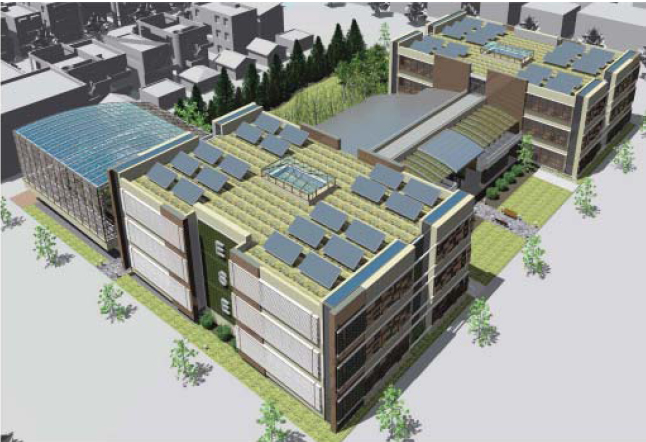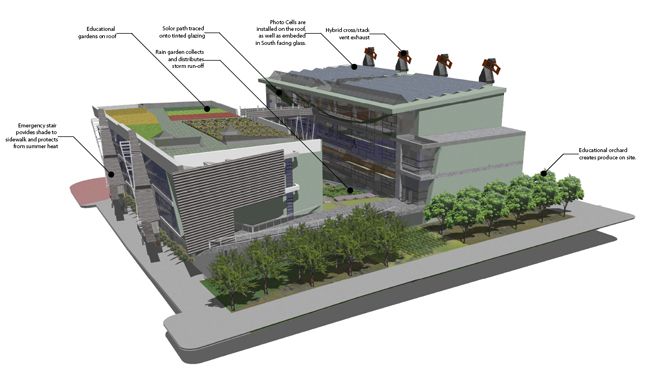Fall 2007 Arch. 451: Architecture Design V (UG) Carbon Neutral Studio
Building Massing / Site Design

Design Performance Objective |
Building Massing/Site Diagram
A southeast view of the building massing reveals the strategy of working on a primarily north-south oriented site. The student subdivided the program requirements for this school into two main classroom blocks, both maximizing an east-west orientation to maximise southern exposure. South facade and east facade are treated differently according to their orientation.
|
Student: Tyler Hughes
|
Software/Tools: |
none |
|
Fall 2007 Arch. 451: Architecture Design V (UG) Carbon Neutral Studio
Building Massing / Site Design
This topic is a critical first step. The building massing must address passive solar as a foundational site opportunity.
If we consider thermal mass storage of passively gained solar radiation a given for CND, then, then the south façade of all buildings must include a passive strategy. Of course this introduces a host of compromises to daylighting, glare, energy modeling, etc. all of which make the design studio experience richer.
|
Investigative Strategy |
Students investigate site plan adaptations to a square site with a building program that requires a single story over the entire site, or a vertical solution. The students measured the relationships of surface area on the south and north elevations against the surface areas of the east and west elevations and strove to accomplish a 2:1 ratio. Not that this is a magic ratio, but it pushes the design solution into the right arena of a building mass that is east-west in its orientation, and sets the stage for more detailed work to follow.
|
Evaluation Process / Criteria |
The student must find a way to mass the built environment in such a way as to maximize wanted solar gain potential, and avoid unwanted solar gain. Of all of the topics, this one is the most straightforward. Yet it is also the one that is the most challenging from a “concept” perspective, because students (and practitioners) often toss out gesture designs that by their very nature are not going to perform well without significant technology. Therefore the assessment for this topic is based upon the very low-tech or pre-tech approach to design at the very beginning stages of the design process. It is pre-tech because it does not yet consider technological solutions. Rather, it sets the stage for low-tech middle ground solutions followed by high-tech end-game solutions. |
|
Information about the Project and Studio |
• course outline
• project outline |
Cautions |
So simple anyone can do it. The main things to avoid are north-south oriented plans and squarish plans. |
Range of Applicability in terms of CLIMATE |
|
Range of Applicability in terms of TYPE |
|
Reference Material |
Regenerative Design for Sustainable Development, John Tillman Lyle, Wiley, ISBN 978-0471178439, Building for Life, Stephen Kellert, Island Press, 2005, ISBN 1-55963-721-8 |
Duration of Exercise |
Very Brief, one or two 4 hour studios. One might consider this a kind of sustainability charrette. |
Degree of Difficulty / Previous Knowledge Required |
Easy enough for a freshman, but meaningful enough for graduate students. |
| |

|
|
Building Massing/Site Design
Thomas Sharp
A southeast view of another solution to the same site. The student plans a garden level first floor on the southern mass and creates an open courtyard between masses connected by enclosed walkways. The student was careful to ensure that the southern mass did not create unwanted winter shadows on the northern mass. This site included significant regeneration concepts as well afforded by a tight building footprint that allowed for on-site produce and landscape architecture. |
|

